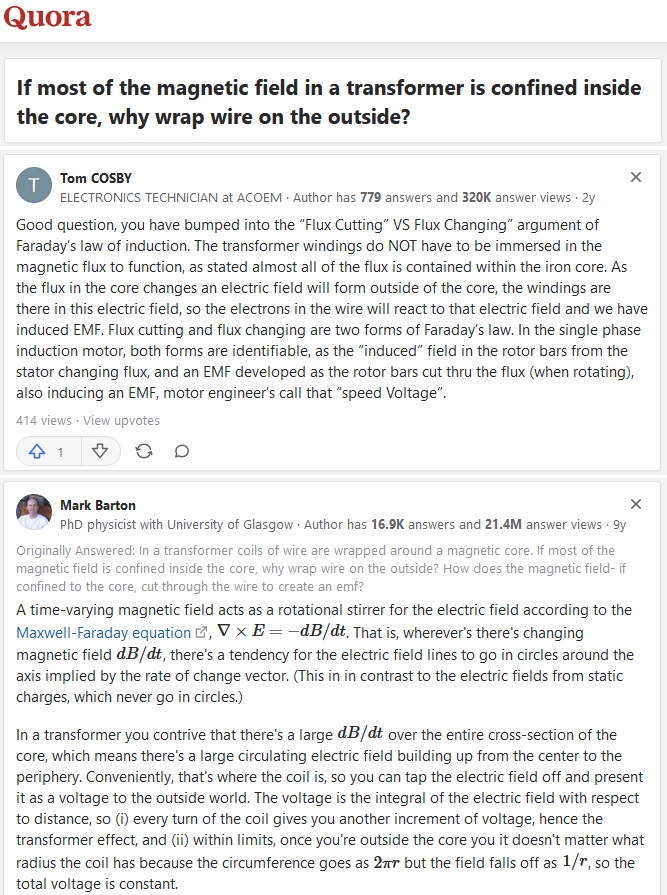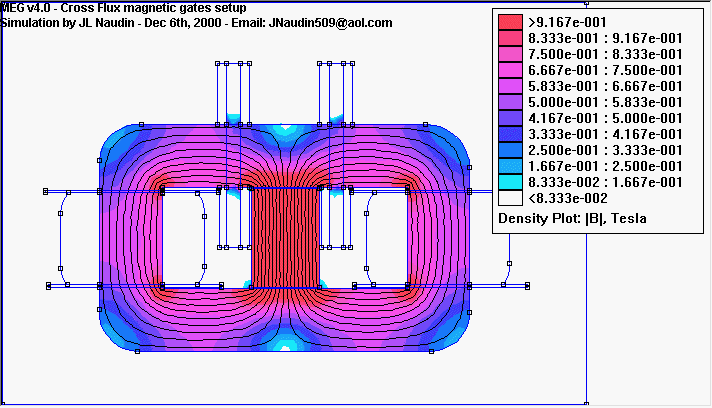I'm starting this thread to present my miscellaneous ideas and experiments.
Costinbuc's Ideas and Experiments
- 2.4K Views
- Last Post 24 March 2024
This image does not show what I mean
On fix magnet +/- 45 at N and S poles should be metal plates on FIX MAGNET
I will try to do a better drawing if powerpoint an paint will allow me
In order to start rotating a manual push should be done on rotating part
Although this is not my prime objective, solid stade motionless generator, I thought I must share it for all of you, just to see an idea to think about
Hi all, I finally got my pole identifier and made the test. The question that rises is: magnetic field is inside of the core ; coils are outside of core. How this works in transformers ?
Hi Costin,
As far as I know in the standard transformers the magnetic field confined in the core doesn't need to interact with the coils wrapped on the core in order to make the transformer work.
More details can be found here and I'm posting just two answers here:
But if we're talking about MEG, that is different and Tom Bearden is explaining very well in a video how MEG is employing the Aharonov-Bohm Effect to become overunity.
Adding some info from my post here.
One of them is what I post here and it's Bearden explanation on how MEG really works. It's a paradigm-shifting video segment and I'd wish I'd saw it few years ago when I was trying to replicate MEG.
This is the video segment I'm talking about:
There are a few paradigm-changing conclusions:
1. J.L. Naudin's explanation on how MEG works is totally wrong. So this simulation is wrong:
The role of the permanent magnet is not to have its magnetic field switched to left and right core sections by the small command coils.
2. Seems that when a permanent magnet is placed inside of the core without gap so the entire magnetic flux of the permanent magnet is "sucked" inside of the core and become trapped there are two effects:
- the permanent magnet become almost inert so it stops emitting magnetic field around it or (depending of how close to 0 mm is the gap between it and the core) it's emitting a very small magnetic field compared to its original magnetic field;
- when the previous conditions are happening and almost all the magnetic field of the permanent magnet is trapped inside the core something new happens: outside of the core a zero-point/quantum/aether (however you call it) field is formed containing additional energy ready to be captured by our device.
3. The practical way of capturing additional energy from that new zero-point/quantum/aether field formed outside of the core is to "shake" that field by pulsing the small command coils on top of the MEG. That will make the output coils capture the additional energy contained in that field therefore zero-point energy is added to the device's output.
4. Tom says MEG's output actually contains multiple and very complex signals which our actual instruments (including the oscilloscopes) are unable or have major difficulties to analyze; he says that because of this there is very difficult to calculate the real energy from the output and expensive specialists and specialized instruments are required for calculating MEG's COP.
5. Seems COP 5 is not the limit for MEG, it can go higher but in the prototype trying to go higher would burn the output coils.
6. He's talking about "nano-crystalline material, there's 2-3 types which would do it"; Metglas AMCC core is actually amorphous metal alloy, not nano-crystalline, so I'm not sure it's one of those 2-3 types Bearden is talking about. What if it's not, what if when placing a permanent magnet inside a AMCC core the magnetic field is not "sucked" and trapped inside the core or what if that zero-point field is not forming around the core ? In my experiments I used AMCC-200 but what if, to really have that zero-point field forming around the core, a nano-crystalline core like Hitachi F3CC0125 is required ? Since seems that zero-point field forming outside of the core cannot be detected directly is difficult to verify if amorphous metal cores are able to have that effect or not. If not then I experimented for years with a wrong core so this is a important question which I have no answer for it right now.
I watched the video many times in order to understand Tom Bearden's explanation, I recommend to you to do the same because every detail is important in what Tom Bearden is telling to us.
About your configuration, the fact that you don't detect magnetic field on the surface of the core is a good thing because it means the entire magnetic field of the permanent magnets is confined in the core. According to Tom Bearden, when this happens then around the core an electric field should appear (because of the Aharonov-Bohm Effect).
As Tom Bearden says in the video:
Every time I shake or perturb this A potential it makes an E field... And the sharper the change the greater the size of the E field from space around the core. This does not happen in any other normal transformer in the whole world as far as we're aware. From the space outside the MEG there arises then these tremendously strong E fields which radiate into every coil it's rounded on this transformer.... The biggest action in the MEG is an electric field transformer not a magnetic field transformer...
So around the core the field should be electric not magnetic. And in MEG that electric field is disturbed/pulsed by the small coils placed in the top of the MEG so the electric field will interact with the big coils placed on the left and right sides of the MEG inducing energy into them.
Regards,
Fighter
| "If you want to find the secrets of the universe, think in terms of energy, frequency and vibration." | ||
| Nikola Tesla | ||
Thank you Fighter.
I suspected that it was about the electric field, but I wanted to be sure that I correctly understood.
Unfortunately I could not measure the electric field outside of core with magnets placed as in MEG - apparatus shows 0 (zero)
As you can see in above clip (except little innacurracy due to lack of necessary magnets size to exactly fit the core and the metal washer placed there to close the loop) it is clear the magnetic field is confined into the core.
I guess next test should be made with coils ; square, saw or sinusoidal wave.
I need to shake that E-field
Is it someone who made a successfull replication ? I meean COP 3-5 ?
- Liked by
-
-
-

-

- and 1 others
Quoting:costinbuc
Thank you Fighter.
I suspected that it was about the electric field, but I wanted to be sure that I correctly understood.
Unfortunately I could not measure the electric field outside of core with magnets placed as in MEG - apparatus shows 0 (zero)
Maybe there is a way but take this as an untested hypothesis, there is a post here containing Munny's idea:
Would be interesting to see what happens if there were several stryfoam balls suspended from threads hanging over that coil. Bet they would be dancing everwhere.
Styrofoam should be affected by an electric field like we know it's affected by static electricity.
I guess next test should be made with coils ; square, saw or sinusoidal wave.
I need to shake that E-field
I agree, seems to be the next logical step.
Is it someone who made a successfull replication ? I meean COP 3-5 ?
MEG replication ? I don't know anyone who did it but I intend to try the new approach (with Aharonov-Bohm effect) when I'll have time...
Thank you Fighter.
You're welcome !
Fighter
| "If you want to find the secrets of the universe, think in terms of energy, frequency and vibration." | ||
| Nikola Tesla | ||
Aharonov-Bohm effect is real. Proved by my experiments even not perfect ones
- Liked by
-
-

-

-
- and 1 others
The big problem is that I can not measure E-field outside of core
- Liked by
-

-

-
-
- and 1 others
-

-

-
-

-
-

-

-

-
-




